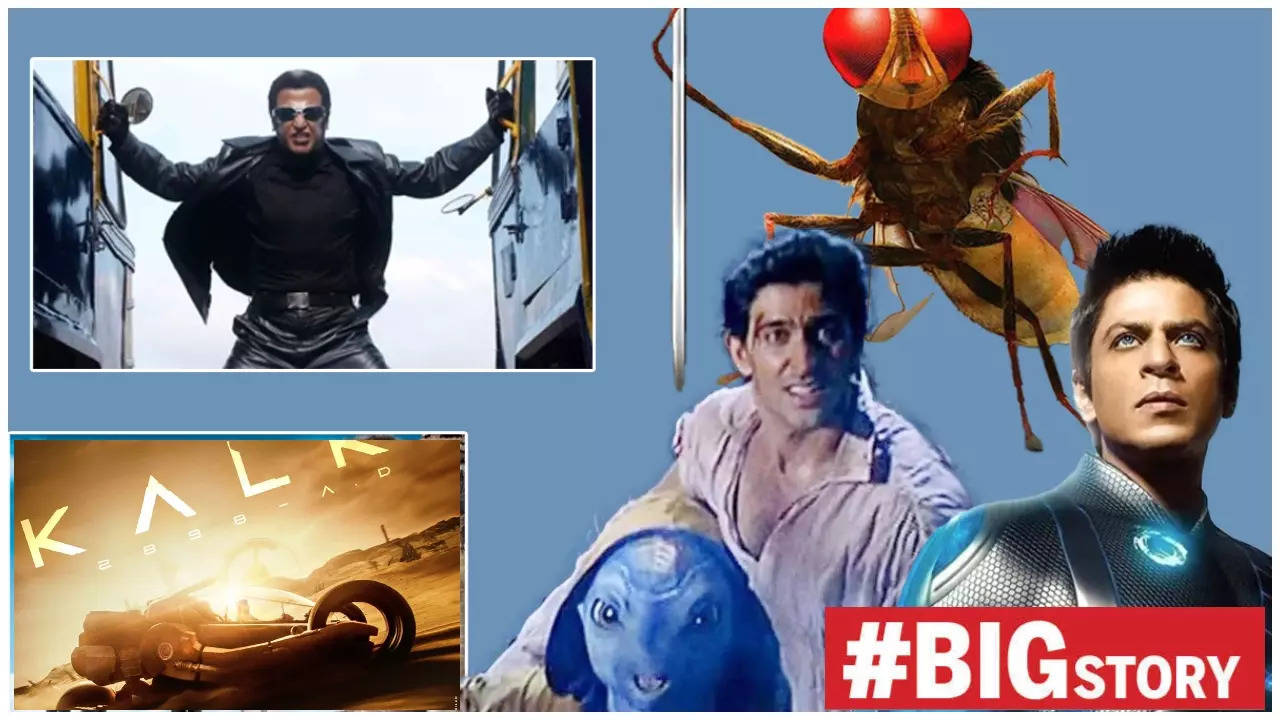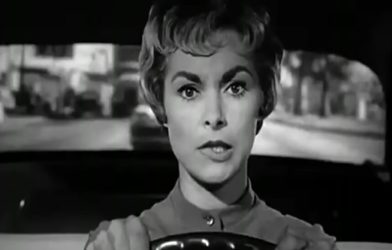Indian cinema is renowned for its rich storytelling and innovative characters. Among these are some non-human and unconventional characters that have left an indelible mark on audiences. From robots and spirits to loyal animals, these unique characters have captivated viewers and enriched the cinematic experience. Let’s look into the fascinating world of unconventional characters that have defined and redefined Indian cinema over the years.
Naga Chaitanya Drives Bujji
One of the highly ambitious upcoming pan-Indian films, ‘Kalki 2898 AD,’ introduces an extraordinary character named Bujji. In this mythological sci-fi film, starring Prabhas, Bujji is a futuristic car with a unique personality, voiced by Keerthy Suresh. Bujji plays a crucial role as the sidekick of Prabhas’s character, Bhairava.
Recently, Tollywood star Naga Chaitanya drove the futuristic car and expressed his admiration for the makers, saying, “I am still in shock. You’ve broken all the rules of engineering.”
The character of Bujji represents cutting-edge technology and creativity in Indian cinema. As a robot car, Bujji not only aids Bhairava as the bounty hunter but also adds a unique touch to the film, showcasing advanced artificial intelligence with human-like traits.
Magical Character in ‘Krrish’
Sanjay Masoom, who is the writer of India’s superhero ‘Krrish’, recently spoke to TOI about the inclusion of magical characters in Bollywood films.
When asked about the decision to include a magical character and whether there were concerns about audience acceptance, Sanjay Masoom shared his insights: “While ‘Krrish’ continued the magical elements introduced in ‘Koi Mil Gaya,’ it was essential to maintain the emotional attachment that audiences had with the earlier film,” he said.
“Since the magic in ‘Koi Mil Gaya’ was well received, we decided to carry it forward in ‘Krrish.’ However, it was crucial to ensure that the same emotions resonated with the audience. Creating a character who is not of this world, an alien, meant that his dialogue had to be carefully crafted. For instance, when Rohit created a complete theory about light, it required significant effort from the team, especially from Varun Shah, to bring this unconventional character to life,” he added.
Dedication and conviction play a major role in bringing these characters to life.
Discussing the challenges and successes of unconventional characters, Masoom reflected on the importance of conviction from the director and the team: “Every new character introduces a tension or dilemma because predicting audience reactions is always uncertain. For example, when Gabbar was introduced in ‘Sholay,’ there was significant apprehension, yet he became an iconic character. The director’s conviction plays a vital role in the success of unconventional characters. I recall working with Rakesh Roshan on ‘Krrish,’ where his conviction in the character’s success was unwavering.”
Masoom highlighted other unconventional characters that have worked well with audiences; he said, “Characters like Makhi, from the film ‘Eega’ (Makhi), are great examples. The conviction of director S.S. Rajamouli made the character work despite its unconventional nature. My experience with such characters, including those with magical elements, says that strong conviction and dedicated effort are key to their success.”
The Eega Marvel and the Cinematography Used for It
Indian cinema has a history of introducing unconventional characters. In 2012, the movie ‘Eega,’ directed by SS Rajamouli, featured a highly unusual protagonist—a housefly. The film tells the story of a man who is murdered and reincarnated as a housefly to avenge his death. Despite being a tiny insect, the character of Eega became an entertaining figure among fans, showcasing the hard work involved in capturing and presenting such visuals.
Speaking to Film Companion, Senthil, the cinematographer of the film, discussed the challenges they faced. “When we were doing research for this film, we caught so many flies. We found out that if we expose them to cold temperatures, they become unconscious for some time. We used microphotography to study them.”
He also added, “Eega was more challenging than ‘RRR’. We had no reference point. We had not seen anyone do it. The closest that people could come to doing something like this was animation. I watched ‘A Bug’s Life’ for inspiration but hadn’t done something like this in real life. Creating the hero of the film, which was a fly, was the biggest challenge.”
‘Eega’ stands out for its extraordinary visual effects and the emotional depth of its tiny protagonist. The film’s success lies in making an insect’s journey as compelling and engaging as any human character’s. The research and innovative cinematography techniques used to bring Eega to life set a new standard in Indian cinema.
The Robotic World
Directed by Shankar, ‘Enthiran’ (2010) features Rajinikanth as Chitti, a humanoid robot. Chitti’s journey from a mere machine to developing human-like emotions drives the plot of the story. The film explores themes of artificial intelligence, ethics, and the emotional consequences of creating life-like robots.
In the recently released Bollywood film ‘Teri Baaton Mein Aisa Uljha Jiya,’ Kriti Sanon plays SIFRA, a highly advanced humanoid robot created by Shahid Kapoor’s character Aryan. SIFRA possesses human-like qualities, including the ability to learn, feel emotions, and form relationships. Kriti Sanon explained the uniqueness of her role in an interview with Not Just Bollywood, saying, “This role was really unique because SIFRA is so close to being a human that a robotic engineer doesn’t realize she is a robot. It was a constant challenge to balance between being too robotic and too human.”
The portrayal of robots like Chitti and SIFRA shows Indian cinema’s fascination with the intersection of technology and humanity.
One of the beloved characters from the film industry, in 2011, Bollywood superstar Shah Rukh Khan starred in ‘Ra. One,’ a groundbreaking film in the realm of Indian sci-fi. The movie features an unconventional character, G.One, a superhero created by a game designer to combat the antagonist, Ra.One, a powerful AI villain. G.One, played by Shah Rukh Khan, is a highly advanced robotic character who brought some unique special effects and motion capture technology of that time to the Indian film industry.
Shah Rukh Khan’s portrayal of G. One, with his superhuman abilities and emotional depth, added a unique dimension to the character, making him both relatable and awe-inspiring. The movie’s exploration of themes like artificial intelligence, virtual reality, and the human-robot relationship captivated audiences and showcased the potential of Indian cinema to blend technology with storytelling. ‘Ra. One’ remains a significant film for its ambitious vision and the introduction of one of the most memorable non-human characters in Indian cinema.
Animals and How They Add Delight to Films
Filmmakers have also showcased animals as main characters, creating heartwarming and memorable narratives. In the film ‘777 Charlie,’ a Labrador dog named Charlie plays a central role, exploring themes of companionship and the deep bond between the dog and its owner. Rakshit Shetty, the film’s producer and actor, shared with The New India Express that “777 Charlie’s central plot of a dog coming into a human’s life to change him was perfect. It continues to affect me every single time I watch it.”
Charlie’s character resonates deeply with audiences, showing the profound impact pets can have on human lives. The film’s success highlights the universal appeal of stories that explore the human-animal bond.
Another unforgettable animal character is Tuffy, the dog from ‘Hum Aapke Hain Koun!’ Tuffy plays a key supporting role, adding to the film’s entertaining and playful elements. Tuffy’s actions are pivotal to the plot, and his presence adds charm and humor to the story, making him a beloved character in Indian cinema.
‘Haathi Mera Saathi,’ an Indian classic, explores the bond between a man and his elephants. The elephants are central to the plot, and their relationships with the human characters add emotional depth to the story. The film’s portrayal of this unique bond highlights the importance of compassion and understanding between humans and animals, offering a powerful narrative that resonates with audiences of all ages.
The supernatural effect
Indian cinema has also embraced supernatural characters, adding a mystical dimension to storytelling. In the film ‘Bhoothnath,’ Amitabh Bachchan plays Bhootnath, a friendly ghost who befriends a young boy. Bhootnath’s character combines humor, wisdom, and emotion, making him a memorable figure in Indian cinema. The film’s blend of supernatural elements with heartwarming relationships offers a unique viewing experience that appeals to both children and adults.
Anushka Sharma’s role as a ghost in ‘Phillauri’ further made an impact. In the film, Sharma’s character Shashi is a friendly spirit who forms an unexpected bond with the protagonist. The film blends comedy, romance, and supernatural elements, showcasing how unconventional characters can add depth to the story.
Recently, Bollywood has embraced an unconventional character with the release of the horror-comedy film ‘Munjya’, starring Mona Singh, Sharvari Wagh, and Abhay Verma. The film, directed by Aditya Sarpotdar, has been performing strongly at the box office and features an intriguing CGI character in the role of a spirit named Munjya.
Speaking to TOI about the role of unconventional characters in cinema, Aditya Sarpotdar said, “Regarding Munjya, I feel reassured that an unconventional CGI character is attracting more audience attention than some of the bigger stars in Bollywood. This demonstrates the power of storytelling and out-of-the-box narratives, which is what audiences are truly seeking. A character like Munjya, who emerges from folklore and is brought to life by the team and filmmakers, captures the audience’s imagination. The biggest strength of such characters is their rootedness in Indian folklore. So I feel that is the biggest strength.”
When asked about the inspiration behind Munjya, Sarpotdar shared, “I have a deep connection with folklore. Characters like Jadoo are also great examples, but folklore has a unique charm. These are stories passed down through generations, and if they withstand the test of time, there is something inherently special about them. That special quality is what drew us to create Munjya, and it’s also what resonates with the audience. Creating Munjya in CGI allowed me to bring to life the version I imagined as a child. Growing up in my hometown, we often heard stories of Munjya. The version I envisioned then is the one I wanted to present to the audience. Characters like Munjya appeal to younger audiences who enjoy the world of fantasy.”
The Impact of Unconventional Characters
Malayalam actress Aishwarya Nambiar, who has worked in films such as ‘Money Back Policy’ and ‘Study Holidays’, spoke with us: “Unconventional characters bring an offbeat and thought-provoking perspective to the movie, which allows to push the boundaries of imagination and expectations of the audience while bending reality from the stereotypical stories. It unleashes the potential of contemplation of the unknown by exploring ethical and moral dilemmas, thus allowing the delivery of a personalized narrative to the audience,” she said.
These characters challenge the norms and conventions of traditional storytelling, offering fresh and engaging perspectives. Whether it’s a robot grappling with human emotions, a housefly seeking revenge, or a ghost offering guidance, They invite audiences to explore new worlds and ideas, which is what cinema is about—bringing stories and creative imagination to life behind a camera to capture.
Characters Driving Drama and Narrative
What these characters do is shape the story, providing viewers with a sense of companionship. The success of films like ‘Enthiran,’ ‘Ra. One,’ and ‘Eega’ demonstrates the power of unconventional characters to captivate audiences and drive the story forward.
The development of such characters often involves significant creative and technical efforts. For instance, the character of Chitti in ‘Enthiran’ required advanced robotics and CGI to bring his complex emotions and actions to life. Similarly, the housefly in ‘Eega’ was created using cutting-edge visual effects and meticulous research, ensuring that the character was both believable and engaging.
Technological advancements and creative innovation
The creation of unconventional characters often necessitates technological advancements and creative innovation. The use of CGI, motion capture, and advanced robotics has enabled filmmakers to push the boundaries of what is possible in cinema. These technologies allow for the seamless integration of non-human characters into live-action narratives, creating a more immersive and believable world for audiences.
Audience engagement and emotional connection
Unconventional characters often evoke strong emotional responses from audiences. Their unique perspectives and challenges can resonate deeply, creating a lasting impact. Characters like Bujji, Eega, and SIFRA offer audiences a glimpse into worlds that are both fantastical and relatable.
The Future of Unconventional Characters in Indian CinemaLooking ahead, the future of unconventional characters in Indian cinema appears bright. As technology continues to evolve and filmmakers become more adventurous, we can expect to see even more innovative and captivating characters.
Upcoming films like ‘Kalki 2898 AD’ and other ambitious projects might also promise to introduce audiences to a new generation of unconventional characters.
Naga Chaitanya Drives Bujji
(Picture Courtesy: Facebook)
One of the highly ambitious upcoming pan-Indian films, ‘Kalki 2898 AD,’ introduces an extraordinary character named Bujji. In this mythological sci-fi film, starring Prabhas, Bujji is a futuristic car with a unique personality, voiced by Keerthy Suresh. Bujji plays a crucial role as the sidekick of Prabhas’s character, Bhairava.
Recently, Tollywood star Naga Chaitanya drove the futuristic car and expressed his admiration for the makers, saying, “I am still in shock. You’ve broken all the rules of engineering.”
The character of Bujji represents cutting-edge technology and creativity in Indian cinema. As a robot car, Bujji not only aids Bhairava as the bounty hunter but also adds a unique touch to the film, showcasing advanced artificial intelligence with human-like traits.
Magical Character in ‘Krrish’
(Picture Courtesy: Facebook)
Sanjay Masoom, who is the writer of India’s superhero ‘Krrish’, recently spoke to TOI about the inclusion of magical characters in Bollywood films.
When asked about the decision to include a magical character and whether there were concerns about audience acceptance, Sanjay Masoom shared his insights: “While ‘Krrish’ continued the magical elements introduced in ‘Koi Mil Gaya,’ it was essential to maintain the emotional attachment that audiences had with the earlier film,” he said.
“Since the magic in ‘Koi Mil Gaya’ was well received, we decided to carry it forward in ‘Krrish.’ However, it was crucial to ensure that the same emotions resonated with the audience. Creating a character who is not of this world, an alien, meant that his dialogue had to be carefully crafted. For instance, when Rohit created a complete theory about light, it required significant effort from the team, especially from Varun Shah, to bring this unconventional character to life,” he added.
Dedication and conviction play a major role in bringing these characters to life.
Discussing the challenges and successes of unconventional characters, Masoom reflected on the importance of conviction from the director and the team: “Every new character introduces a tension or dilemma because predicting audience reactions is always uncertain. For example, when Gabbar was introduced in ‘Sholay,’ there was significant apprehension, yet he became an iconic character. The director’s conviction plays a vital role in the success of unconventional characters. I recall working with Rakesh Roshan on ‘Krrish,’ where his conviction in the character’s success was unwavering.”
Masoom highlighted other unconventional characters that have worked well with audiences; he said, “Characters like Makhi, from the film ‘Eega’ (Makhi), are great examples. The conviction of director S.S. Rajamouli made the character work despite its unconventional nature. My experience with such characters, including those with magical elements, says that strong conviction and dedicated effort are key to their success.”
The Eega Marvel and the Cinematography Used for It
(Picture Courtesy: Facebook)
Indian cinema has a history of introducing unconventional characters. In 2012, the movie ‘Eega,’ directed by SS Rajamouli, featured a highly unusual protagonist—a housefly. The film tells the story of a man who is murdered and reincarnated as a housefly to avenge his death. Despite being a tiny insect, the character of Eega became an entertaining figure among fans, showcasing the hard work involved in capturing and presenting such visuals.
Speaking to Film Companion, Senthil, the cinematographer of the film, discussed the challenges they faced. “When we were doing research for this film, we caught so many flies. We found out that if we expose them to cold temperatures, they become unconscious for some time. We used microphotography to study them.”
He also added, “Eega was more challenging than ‘RRR’. We had no reference point. We had not seen anyone do it. The closest that people could come to doing something like this was animation. I watched ‘A Bug’s Life’ for inspiration but hadn’t done something like this in real life. Creating the hero of the film, which was a fly, was the biggest challenge.”
‘Eega’ stands out for its extraordinary visual effects and the emotional depth of its tiny protagonist. The film’s success lies in making an insect’s journey as compelling and engaging as any human character’s. The research and innovative cinematography techniques used to bring Eega to life set a new standard in Indian cinema.
The Robotic World
(Picture Courtesy: Facebook)
Directed by Shankar, ‘Enthiran’ (2010) features Rajinikanth as Chitti, a humanoid robot. Chitti’s journey from a mere machine to developing human-like emotions drives the plot of the story. The film explores themes of artificial intelligence, ethics, and the emotional consequences of creating life-like robots.
In the recently released Bollywood film ‘Teri Baaton Mein Aisa Uljha Jiya,’ Kriti Sanon plays SIFRA, a highly advanced humanoid robot created by Shahid Kapoor’s character Aryan. SIFRA possesses human-like qualities, including the ability to learn, feel emotions, and form relationships. Kriti Sanon explained the uniqueness of her role in an interview with Not Just Bollywood, saying, “This role was really unique because SIFRA is so close to being a human that a robotic engineer doesn’t realize she is a robot. It was a constant challenge to balance between being too robotic and too human.”
The portrayal of robots like Chitti and SIFRA shows Indian cinema’s fascination with the intersection of technology and humanity.
One of the beloved characters from the film industry, in 2011, Bollywood superstar Shah Rukh Khan starred in ‘Ra. One,’ a groundbreaking film in the realm of Indian sci-fi. The movie features an unconventional character, G.One, a superhero created by a game designer to combat the antagonist, Ra.One, a powerful AI villain. G.One, played by Shah Rukh Khan, is a highly advanced robotic character who brought some unique special effects and motion capture technology of that time to the Indian film industry.
Shah Rukh Khan’s portrayal of G. One, with his superhuman abilities and emotional depth, added a unique dimension to the character, making him both relatable and awe-inspiring. The movie’s exploration of themes like artificial intelligence, virtual reality, and the human-robot relationship captivated audiences and showcased the potential of Indian cinema to blend technology with storytelling. ‘Ra. One’ remains a significant film for its ambitious vision and the introduction of one of the most memorable non-human characters in Indian cinema.
Animals and How They Add Delight to Films
Filmmakers have also showcased animals as main characters, creating heartwarming and memorable narratives. In the film ‘777 Charlie,’ a Labrador dog named Charlie plays a central role, exploring themes of companionship and the deep bond between the dog and its owner. Rakshit Shetty, the film’s producer and actor, shared with The New India Express that “777 Charlie’s central plot of a dog coming into a human’s life to change him was perfect. It continues to affect me every single time I watch it.”
Charlie’s character resonates deeply with audiences, showing the profound impact pets can have on human lives. The film’s success highlights the universal appeal of stories that explore the human-animal bond.
Another unforgettable animal character is Tuffy, the dog from ‘Hum Aapke Hain Koun!’ Tuffy plays a key supporting role, adding to the film’s entertaining and playful elements. Tuffy’s actions are pivotal to the plot, and his presence adds charm and humor to the story, making him a beloved character in Indian cinema.
‘Haathi Mera Saathi,’ an Indian classic, explores the bond between a man and his elephants. The elephants are central to the plot, and their relationships with the human characters add emotional depth to the story. The film’s portrayal of this unique bond highlights the importance of compassion and understanding between humans and animals, offering a powerful narrative that resonates with audiences of all ages.
The supernatural effect
Indian cinema has also embraced supernatural characters, adding a mystical dimension to storytelling. In the film ‘Bhoothnath,’ Amitabh Bachchan plays Bhootnath, a friendly ghost who befriends a young boy. Bhootnath’s character combines humor, wisdom, and emotion, making him a memorable figure in Indian cinema. The film’s blend of supernatural elements with heartwarming relationships offers a unique viewing experience that appeals to both children and adults.
Anushka Sharma’s role as a ghost in ‘Phillauri’ further made an impact. In the film, Sharma’s character Shashi is a friendly spirit who forms an unexpected bond with the protagonist. The film blends comedy, romance, and supernatural elements, showcasing how unconventional characters can add depth to the story.
Recently, Bollywood has embraced an unconventional character with the release of the horror-comedy film ‘Munjya’, starring Mona Singh, Sharvari Wagh, and Abhay Verma. The film, directed by Aditya Sarpotdar, has been performing strongly at the box office and features an intriguing CGI character in the role of a spirit named Munjya.
Speaking to TOI about the role of unconventional characters in cinema, Aditya Sarpotdar said, “Regarding Munjya, I feel reassured that an unconventional CGI character is attracting more audience attention than some of the bigger stars in Bollywood. This demonstrates the power of storytelling and out-of-the-box narratives, which is what audiences are truly seeking. A character like Munjya, who emerges from folklore and is brought to life by the team and filmmakers, captures the audience’s imagination. The biggest strength of such characters is their rootedness in Indian folklore. So I feel that is the biggest strength.”
When asked about the inspiration behind Munjya, Sarpotdar shared, “I have a deep connection with folklore. Characters like Jadoo are also great examples, but folklore has a unique charm. These are stories passed down through generations, and if they withstand the test of time, there is something inherently special about them. That special quality is what drew us to create Munjya, and it’s also what resonates with the audience. Creating Munjya in CGI allowed me to bring to life the version I imagined as a child. Growing up in my hometown, we often heard stories of Munjya. The version I envisioned then is the one I wanted to present to the audience. Characters like Munjya appeal to younger audiences who enjoy the world of fantasy.”
The Impact of Unconventional Characters
(Picture Courtesy: Facebook)
Malayalam actress Aishwarya Nambiar, who has worked in films such as ‘Money Back Policy’ and ‘Study Holidays’, spoke with us: “Unconventional characters bring an offbeat and thought-provoking perspective to the movie, which allows to push the boundaries of imagination and expectations of the audience while bending reality from the stereotypical stories. It unleashes the potential of contemplation of the unknown by exploring ethical and moral dilemmas, thus allowing the delivery of a personalized narrative to the audience,” she said.
These characters challenge the norms and conventions of traditional storytelling, offering fresh and engaging perspectives. Whether it’s a robot grappling with human emotions, a housefly seeking revenge, or a ghost offering guidance, They invite audiences to explore new worlds and ideas, which is what cinema is about—bringing stories and creative imagination to life behind a camera to capture.
Characters Driving Drama and Narrative
What these characters do is shape the story, providing viewers with a sense of companionship. The success of films like ‘Enthiran,’ ‘Ra. One,’ and ‘Eega’ demonstrates the power of unconventional characters to captivate audiences and drive the story forward.
The development of such characters often involves significant creative and technical efforts. For instance, the character of Chitti in ‘Enthiran’ required advanced robotics and CGI to bring his complex emotions and actions to life. Similarly, the housefly in ‘Eega’ was created using cutting-edge visual effects and meticulous research, ensuring that the character was both believable and engaging.
Technological advancements and creative innovation
The creation of unconventional characters often necessitates technological advancements and creative innovation. The use of CGI, motion capture, and advanced robotics has enabled filmmakers to push the boundaries of what is possible in cinema. These technologies allow for the seamless integration of non-human characters into live-action narratives, creating a more immersive and believable world for audiences.
Audience engagement and emotional connection
Unconventional characters often evoke strong emotional responses from audiences. Their unique perspectives and challenges can resonate deeply, creating a lasting impact. Characters like Bujji, Eega, and SIFRA offer audiences a glimpse into worlds that are both fantastical and relatable.
The Future of Unconventional Characters in Indian CinemaLooking ahead, the future of unconventional characters in Indian cinema appears bright. As technology continues to evolve and filmmakers become more adventurous, we can expect to see even more innovative and captivating characters.
Upcoming films like ‘Kalki 2898 AD’ and other ambitious projects might also promise to introduce audiences to a new generation of unconventional characters.









